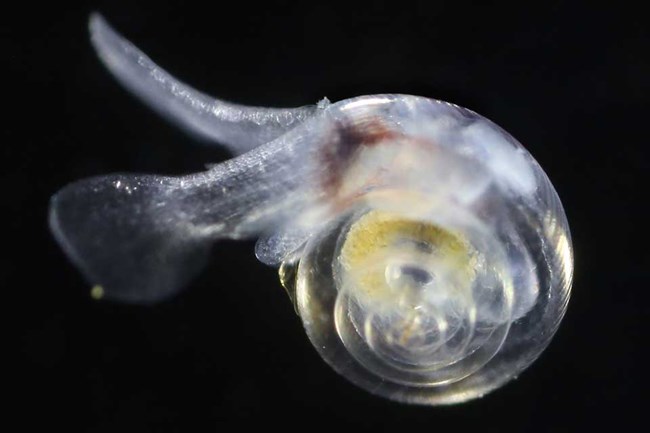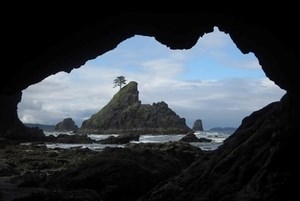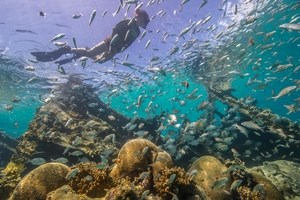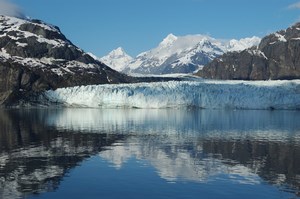
NOAA
From the rocky coastline of the Pacific Northwest to the coral reefs of the Caribbean, the ocean plays an important role for all life and ecosystems on earth. The ocean produces 70% of the oxygen in the atmosphere and helps regulate the earth’s climate so that it is a habitable place for people and animals to survive and thrive.
Cause of Ocean Acidification
The ocean naturally absorbs over a quarter of the carbon dioxide (CO2) in the atmosphere, which is used by marine algae and other organisms to grow and produce oxygen. However, since the start of the industrial revolution, the level of atmospheric CO2 has dramatically climbed due to human activities that burn fossil fuels, like oil and coal, for things like electricity and transportation. As a result of rising atmospheric CO2 concentrations, levels of CO2 in the ocean are also increasing. This is causing ocean conditions around the world to change which is presenting new challenges for marine life and ecosystems.
When CO2 enters the ocean it reacts with sea water and forms carbonic acid (H2Co3). Carbonic acid is a weak acid which separates or dissociates into a hydrogen ion (H+) and a bicarbonate ion (HCO3-). Scientists use the pH scale to measure the amount of hydrogen ions in a substance because hydrogen ions determine the acidity of a substance. When there are more hydrogen ions in a substance, then it is acidic and has a lower pH (1-6 on pH scale). When there are less hydrogen ions in a substance, then it is basic and has a higher pH (8-14 on pH scale). A pH of 7 is neutral, neither acidic nor basic.
As more hydrogen ions are formed from the chemical reaction between CO2 and seawater, the pH of the ocean is starting to decrease, meaning it is becoming more acidic. This is called ocean acidification (OA).
The pH scale is logarithmic, similar to the Richter scale. This means that each whole pH value below 7 is ten times more acidic than the value above it. For example, a pH of 5 is ten times more acidic than 6. Therefore a small drop in pH represents a big change! Over the last 200 years, the pH of the ocean has dropped from 8.2 to 8.1, which means it has become 30% more acidic. The last time the ocean was this acidic was over 300 million years ago!
Challenges for Marine Life
Ocean acidification is making life more challenging for some marine species, especially shell-building organisms like oysters, mussels, crabs, and corals. This is because these organisms need calcium carbonate to develop their shells and skeletons. Since the ocean is becoming more acidic, there is less carbonate ions available for these organisms who need it.
With less calcium carbonate available, shell-building organisms grow slower and build weaker shells, leaving them vulnerable to threats and predators. Many of these organisms make up the basis of the food chain, potentially leading to a domino-like effect that can impact many species who rely on them as a source of food.
Ocean Acidification in National Parks
Ocean acidification (OA) is a clear and present threat to marine resources in ocean and coastal parks. However changing ocean conditions affect marine resources and ecosystems of each park differently depending on natural oceanographic processes, seasonal conditions, and freshwater inputs. Currently nine national parks, monuments and historical sites have started research and monitoring programs to better understand how marine ecosystems are responding to acidic ocean conditions.
From research and modeling to citizen-science, the NPS and its partners are committed to learning about and understanding the dynamics of ocean acidification along varied coastlines. By researching and monitoring ocean pH, scientists and managers have an opportunity to establish a better understanding of how acidic ocean conditions will impact species and ecological systems to best protect these resources future generations. Read below to see how parks from coast to coast are addressing ocean acidification.

NPS Photo
Park Research
Olympic National Park began to monitor intertidal OA in 2010 and has continuously monitored two sites since then. Since then, the OA monitoring program has been adopted and implemented by other ocean and coastal parks across the west coast.

NPS Photo
Acadia National Park has partnered with the Schoodic Institute and other partners, where professional scientists and citizen science volunteers collect data on ocean chemistry and biology to monitor the impacts of acidic ocean conditions on intertidal ecosystems.

NPS Photo
In Dry Tortugas and Biscayne National Park work with the U.S. Geological Survey to monit the growth rates of coral reefs to see how they respond changing ocean conditions.

NPS Photo
Cabrillo National Monument began collecting water quality data in the intertidal zone in 2016 to monitor fluctuations in ocean chemistry. This information can be used to inform effective management for intertidal species and habitats within the park.

NPS Photo
Glacier Bay National Park has partnered with the University of Alaska Fairbanks to develop an ocean acidification model for the region to learn how acidic ocean conditions will affect ecosystems and people who depend on them. The park also conducted research to understand how glacial runoff into ocean systems influences ocean acidification.
Additional Resources:
Understanding Ocean AcidificationNOAA OA Program
OA Curriculum Collection
OA Education Tools
Learn More
Last updated: August 24, 2023
